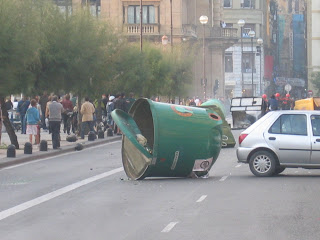PortoHave managed to make it through today without consuming any ham or cheese!!
Porto has a romantic reputation and history. The city is planted with multitudes of camellias which give a colourful and festive air throughout the colder winter months.
It is also renowned for its bridges which are particularly attractive, one of which was designed by Gustav Eiffel.
The city folk celebrate St John´s festival on June 23, when they stay up all night feasting, lighting fireworks, and hitting each other over the head with a squeaky plastic hammer. One must stay up long enough to collect the early morning dew, which is believed to bring good fortune for the coming year.
Porto´s early population was primarily fishermen and boat-builders. It has also developed to service the surrounding countryside (river
Duoro valley) which produces major grape harvests which are transported to Porto to be matured, blended and bottled.
Porto has not always been a tranquil and romantic tourist spot. It has a history of rebelliousness and dissent - in 1628 even the ladies attacked a minister for introducing a tax on linen!
The earliest recorded origins are that Don
Joao I (king John the 1st) married Philippa from England here in 1111, and their son Henry the Navigator was born here. There are many statues and monuments in recognition of Henry, who followed after
Vasco da Gama in explorations to the East.
Interestingly, throughout Portugal which is primarily a Catholic country, there seems to be no evidence of religious statues other than on and in churches. Statues/monuments around the squares are a
myriad of poets, writers, kings, explorers, and other famous people from the past.
The city bus tour today was particularly good - almost two hours, through both the old and newer parts of the city on both sides of the river, and along a portion of the Atlantic ocean and the river. The buildings and streets are rather austere and imposing, against which a McDonald store provided a gaudy contrast. There are many gardens and open squares sprinkled throughout the city, and some of the old buildings and churches are coated with the unique painted blue and white tiles (often depicting a scene using 12cm tiles which have been hand painted and fired).
In the morning we walked down to the river from the main cathedral through tiny alleyways
and footpaths past small domestic residences - great photographic opportunity.
The city is also known for "tripe", cooked into a stew. This began in 1415 when Henry the Navigator left to sail for Morocco, Porto´s loyal citizens donated their best meat to the sailors and kept the offal for
themselves (earning the nickname "tripe-eaters").
Porto is a beautiful city on the banks of the Douro river and a traveller´s delight with wall to wall restaurants along the river bank and loads of historical sights.





















